Seafloor Stability Assessment of Jiaxie Seamount Group Using the “Weight-of-Evidence” (WoE) Method, Western Pacific Ocean
Abstract
1. Introduction
2. Geological Background
3. Data and Methods
3.1. Data Acquisition and Processing
3.2. Failure Zone Identification
3.3. Assessment Indicator System
3.4. Weight-of-Evidence Modeling
3.4.1. A Priori Probability Calculation
3.4.2. A Posteriori Probability and Odds Calculation
3.4.3. Weight-of-Evidence Calculation
3.4.4. Failure Probability Calculation
3.5. ROC Curve
4. Results and Discussion
4.1. Seamount Failure Zones
4.2. Analysis of the Independence of Assessment Indicators
4.3. Assessment of Seamount Stability
4.3.1. Weight of Evidence
4.3.2. Failure Probability
4.3.3. Stability Zoning Assessment
4.4. WoE Model Validation
5. Conclusions
- (1)
- There are obvious slope failure features in the Jiaxie Seamount Group, and typical slope failure zones, avalanche debris, and debris accumulation zones can be identified based on topographic features. Slope failure phenomena are distributed at the summit margins of three guyots: the Weijia, Weizhen, and Weixie Guyots. Among these, failure phenomena occur more frequently at the Weijia Guyot, which is the largest in size;
- (2)
- The six chosen topographic elements—water depth, slope, aspect, planar curvature, profile curvature, and VRM—demonstrate distinct independence and are appropriate for use as assessment indicators in evaluating the stability of seamounts;
- (3)
- The results of the stability zoning assessment for the Jiaxie Seamount Group indicate that the majority of the area falls within the high-stability zone, with less than 4% classified as low-stability and very-low-stability zones. High-stability zones are primarily located on summit platforms, deep-sea plains, and smooth slope surfaces; medium-stability zones are primarily located on relatively smooth steep slopes; and low-stability and very-low-stability zones are predominantly found on the steep edges of the guyots, on the upper ridges, and in areas with high ruggedness;
- (4)
- The results of the stability assessment of the Jiaxie Seamount Group were validated through an ROC curve. The calculated AUC value was 0.929, indicating that the weight-of-evidence method has a high discriminative ability and applicability in evaluating seamount stability.
- (1)
- Due to the difficulty in obtaining deep-sea environmental data, only seafloor topographic data were used for the stability assessment in this study, which may have resulted in a somewhat one-sided assessment;
- (2)
- The weight-of-evidence approach requires the use of a slope failure dataset; however, no deep-sea slope failure databases are available. The dataset used in this study was compiled through a visual analysis of seafloor topography, which means that the data may be subjective.
Author Contributions
Funding
Data Availability Statement
Conflicts of Interest
References
- Jiang, X.; Dong, C.; Ji, Y.; Wang, C.; Shu, Y.; Liu, L.; Ji, J. Influences of Deep-Water Seamounts on the Hydrodynamic Environment in the Northwestern Pacific Ocean. J. Geophys. Res. Ocean. 2021, 126, e2021JC017396. [Google Scholar] [CrossRef]
- Wang, X.; Li, H.; Zhang, J.; Chen, J.; Xie, X.; Xie, W.; Yin, K.; Zhang, D.; Diana, R.; Kao, S.-J. Seamounts Generate Efficient Active Transport Loops to Nourish the Twilight Ecosystem. Sci. Adv. 2024, 10, eadk6833. [Google Scholar] [CrossRef]
- Samadi, S.; Bottan, L.; Macpherson, E.; Forges, B.; Boisselier, M.-C. Seamount Endemism Questioned by the Geographic Distribution and Population Genetic Structure of Marine Invertebrates. Mar. Biol. 2006, 149, 1463–1475. [Google Scholar] [CrossRef]
- Morato, T.; Varkey, D.A.; Damaso, C.; Machete, M.; Santos, M.; Prieto, R.; Santos, R.S.; Pitcher, T.J. Evidence of a Seamount Effect on Aggregating Visitors. Mar. Ecol. Prog. Ser. 2008, 357, 23–32. [Google Scholar] [CrossRef]
- Morato, T.; Hoyle, S.D.; Allain, V.; Nicol, S.J. Seamounts Are Hotspots of Pelagic Biodiversity in the Open Ocean. Proc. Natl. Acad. Sci. USA 2010, 107, 9707–9711. [Google Scholar] [CrossRef]
- Hein, J.; Mizell, K.; Koschinsky, A.; Conrad, T. Deep-Ocean Mineral Deposits as a Source of Critical Metals for High-and Green-Technology Applications: Comparison with Land-Based Resources. Ore Geol. Rev. 2012, 51, 1–14. [Google Scholar] [CrossRef]
- Mizell, K.; Hein, J.R.; Au, M.; Gartman, A. Estimates of Metals Contained in Abyssal Manganese Nodules and Ferromanganese Crusts in the Global Ocean Based on Regional Variations and Genetic Types of Nodules. In Perspectives on Deep-Sea Mining: Sustainability, Technology, Environmental Policy and Management; Sharma, R., Ed.; Springer International Publishing: Cham, Switzerland, 2022; pp. 53–80. ISBN 978-3-030-87982-2. [Google Scholar]
- Holzheid, A.; Zhao, H.; Cabus, T.; Fan, L.; Kuhn, T.; Sun, L.; Tao, C.; Haeckel, M.; Hoang, D.; Kelly, N.; et al. Deep-Sea Mining of Massive Sulfides: Balancing Impacts on Biodiversity and Ecosystem, Technological Challenges and Law of the Sea. Mar. Policy 2024, 167, 106289. [Google Scholar] [CrossRef]
- Liu, X.; Li, H.; Zhou, T.; Xu, C. Multibeam Seafloor Topography-Geomorphology Integrated Detection Technology. In Proceedings of the 2011 International Conference on Multimedia Technology, Hangzhou, China, 26–28 July 2011; pp. 3575–3578. [Google Scholar]
- Kumar, D.; Krishnan, A.; Kuttikrishnan, G.; Ramadass, G.A. Air-Lift Pump Systems for Vertical Solid Particle Transport: A Comprehensive Review and Deep Sea Mining Potential. Ocean. Eng. 2024, 297, 116928. [Google Scholar] [CrossRef]
- Nian, T.; Liu, B.; Yin, P. Seafloor Slope Stability under Adverse Conditions Using Energy Approach. Appl. Mech. Mater. 2013, 405–408, 1445–1448. [Google Scholar] [CrossRef]
- Wang, Y.; Wang, R.; Zhang, J.-M. Large-Scale Seismic Seafloor Stability Analysis in the South China Sea. Ocean. Eng. 2021, 135, 109334. [Google Scholar] [CrossRef]
- Deplus, C.; Le Friant, A.; Boudon, G.; Komorowski, J.-C.; Villemant, B.; Harford, C.; Ségoufin, J.; Cheminée, J.-L. Submarine Evidence for Large-Scale Debris Avalanches in the Lesser Antilles Arc. Earth Planet. Sci. Lett. 2001, 192, 145–157. [Google Scholar] [CrossRef]
- Saint-Ange, F.; Bachèlery, P.; Babonneau, N.; Michon, L.; Jorry, S.J. Volcaniclastic Sedimentation on the Submarine Slopes of a Basaltic Hotspot Volcano: Piton de La Fournaise Volcano (La Réunion Island, Indian Ocean). Mar. Geol. 2013, 337, 35–52. [Google Scholar] [CrossRef]
- Chang, Y.-C.; Mitchell, N.C.; Quartau, R. Landslides in the Upper Submarine Slopes of Volcanic Islands: The Central Azores. Geochem. Geophys. Geosyst. 2021, 22, e2021GC009833. [Google Scholar] [CrossRef]
- Acharya, G.; De Smedt, F.; Long, N.T. Assessing Landslide Hazard in GIS: A Case Study from Rasuwa, Nepal. Bull. Eng. Geol. Environ. 2006, 65, 99–107. [Google Scholar] [CrossRef]
- Ciabatta, L.; Camici, S.; Brocca, L.; Ponziani, F.; Stelluti, M.; Berni, N.; Moramarco, T. Assessing the Impact of Climate-Change Scenarios on Landslide Occurrence in Umbria Region, Italy. J. Hydrol. 2016, 541, 285–295. [Google Scholar] [CrossRef]
- Lin, Q.; Steger, S.; Pittore, M.; Zhang, J.; Wang, L.; Jiang, T.; Wang, Y. Evaluation of Potential Changes in Landslide Susceptibility and Landslide Occurrence Frequency in China under Climate Change. Sci. Total Environ. 2022, 850, 158049. [Google Scholar] [CrossRef]
- Song, Y.; Na, W.; Jun, C.; Kim, S.Y. Comparative Analysis of Slope Stability Factors and a Hydrological Dataset for Landslide Assessment. Nat. Hazards 2025, 121, 3981–3996. [Google Scholar] [CrossRef]
- Vikara, D.; Remson, D.; Khanna, V. Machine Learning-Informed Ensemble Framework for Evaluating Shale Gas Production Potential: Case Study in the Marcellus Shale. J. Nat. Gas Sci. Eng. 2020, 84, 103679. [Google Scholar] [CrossRef]
- Wang, H.; Zhang, L.; Luo, H.; He, J.; Cheung, R.W.M. AI-Powered Landslide Susceptibility Assessment in Hong Kong. Eng. Geol. 2021, 288, 106103. [Google Scholar] [CrossRef]
- Tan, L.; Zhou, M.; Wang, F. A Probabilistic Assessment Framework for Submarine Landslide Susceptibility in Continental Slopes with Rich Gas Hydrates. J. Mar. Sci. Eng. 2023, 11, 1366. [Google Scholar] [CrossRef]
- Wei, X.; Gardoni, P.; Zhang, L.; Tan, L.; Liu, D.; Du, C.; Li, H. Improving Pixel-Based Regional Landslide Susceptibility Mapping. Geosci. Front. 2024, 15, 101782. [Google Scholar] [CrossRef]
- Dondin, F.J.-Y.; Heap, M.J.; Robertson, R.E.A.; Dorville, J.-F.M.; Carey, S. Flank Instability Assessment at Kick-’em-Jenny Submarine Volcano (Grenada, Lesser Antilles): A Multidisciplinary Approach Using Experiments and Modeling. Bull. Volcanol. 2016, 79, 5. [Google Scholar] [CrossRef]
- Govorov, I.N.; Gerasimov, N.S.; Simanenko, V.P. Rubidium-Strontium Isochron of Ankaramite-Trachybasalt Assotiation of the Marcus-Wake Rise (Pacific). Dokl. Akad. Nauk. 1996, 347, 780–783. [Google Scholar]
- Mel’nikov, M.E.; Tugolesov, D.D.; Pletnev, S.P. The Structure of the Incoherent Sediments in the Ita Mai Tai Guyot (Pacific Ocean) Based on Geoacoustic Profiling Data. Oceanology 2010, 50, 582–590. [Google Scholar] [CrossRef]
- Pletnev, S.P. Main Types of Aptian–Cenomanian Sedimentary Rocks on Guyots of the Magellan Mountains, Pacific Ocean. Russ. J. Pac. Geol. 2019, 13, 436–445. [Google Scholar] [CrossRef]
- Bulmer, M.H.; Wilson, J.B. Comparison of Flat-Topped Stellate Seamounts on Earth’s Seafloor with Stellate Domes on Venus Using Side-Scan Sonar and Magellan Synthetic Aperture Radar. Earth Planet. Sci. Lett. 1999, 171, 277–287. [Google Scholar] [CrossRef]
- Wang, X.; Li, H.; Cheng, Y.; Yao, P.; Chu, F.; Ma, W.; Wang, H.; Lv, S.; Li, X.; Li, Z.; et al. Submarine Morphological Description of the Ancient Archipelagic Aprons in the Marcus–Wake Seamount Group, Northwestern Pacific Ocean. J. Mar. Sci. Eng. 2024, 12, 670. [Google Scholar] [CrossRef]
- Becker, J.J.; Sandwell, D.T.; Smith, W.H.F.; Braud, J.; Binder, B.; Depner, J.; Fabre, D.; Factor, J.; Ingalls, S.; Kim, S.-H.; et al. Global Bathymetry and Elevation Data at 30 Arc Seconds Resolution: SRTM30_PLUS. Mar. Geod. 2009, 32, 355–371. [Google Scholar] [CrossRef]
- Bird, P. An Updated Digital Model of Plate Boundaries. Geochem. Geophys. Geosyst. 2003, 4, 1027. [Google Scholar] [CrossRef]
- Wlodarczyk-Sielicka, M.; Blaszczak-Bak, W. Processing of Bathymetric Data: The Fusion of New Reduction Methods for Spatial Big Data. Sensors 2020, 20, 6207. [Google Scholar] [CrossRef]
- Zhao, J.; Yan, J.; Zhang, H.; Zhang, Y.; Wang, A. A New Method for Weakening the Combined Effect of Residual Errors on Multibeam Bathymetric Data. Mar. Geophys. Res. 2014, 35, 379–394. [Google Scholar] [CrossRef]
- Masson, D.G.; Watts, A.B.; Gee, M.J.R.; Urgeles, R.; Mitchell, N.C.; Le Bas, T.P.; Canals, M. Slope Failures on the Flanks of the Western Canary Islands. Earth-Sci. Rev. 2002, 57, 1–35. [Google Scholar] [CrossRef]
- Watt, S.F.L.; Talling, P.J.; Hunt, J.E. New Insights into the Emplacement Dynamics of Volcanic Island Landslides. Oceanography 2015, 27, 46–57. [Google Scholar] [CrossRef]
- Berné, S.; Vagner, P.; Guichard, F.; Lericolais, G.; Liu, Z.; Trentesaux, A.; Yin, P.; Yi, H.I. Pleistocene Forced Regressions and Tidal Sand Ridges in the East China Sea. Mar. Geol. 2002, 188, 293–315. [Google Scholar] [CrossRef]
- Canals, M.; Lastras, G.; Urgeles, R.; Casamor, J.L.; Mienert, J.; Cattaneo, A.; De Batist, M.; Haflidason, H.; Imbo, Y.; Laberg, J.S.; et al. Slope Failure Dynamics and Impacts from Seafloor and Shallow Sub-Seafloor Geophysical Data: Case Studies from the COSTA Project. Mar. Geol. 2004, 213, 9–72. [Google Scholar] [CrossRef]
- Green, A.; Uken, R. Submarine Landsliding and Canyon Evolution on the Northern KwaZulu-Natal Continental Shelf, South Africa, SW Indian Ocean. Mar. Geol. 2008, 254, 152–170. [Google Scholar] [CrossRef]
- Weed, D.L. Weight of Evidence: A Review of Concept and Methods. Risk Anal. 2005, 25, 1545–1557. [Google Scholar] [CrossRef]
- Hardy, A.; Benford, D.; Halldorsson, T.; Jeger, M.J.; Knutsen, H.K.; More, S.; Naegeli, H.; Noteborn, H.; Ockleford, C.; Ricci, A.; et al. Guidance on the Use of the Weight of Evidence Approach in Scientific Assessments. EFSA J. 2017, 15, e04971. [Google Scholar] [CrossRef]
- Velmurugan, J.; Venkatesan, M. Soft Prediction Model for Spatial Data Analysis. Int. J. Glob. Environ. Issues 2018, 17, 130–143. [Google Scholar] [CrossRef]
- Fawcett, T. An Introduction to ROC Analysis. Pattern Recognit. Lett. 2006, 27, 861–874. [Google Scholar] [CrossRef]
- Hand, D.J. Measuring Classifier Performance: A Coherent Alternative to the Area under the ROC Curve. Mach. Learn. 2009, 77, 103–123. [Google Scholar] [CrossRef]
- Kader, G.; Franklin, C. The Evolution of Pearson’s Correlation Coefficient. Math. Teach. 2008, 102, 292–299. [Google Scholar] [CrossRef]

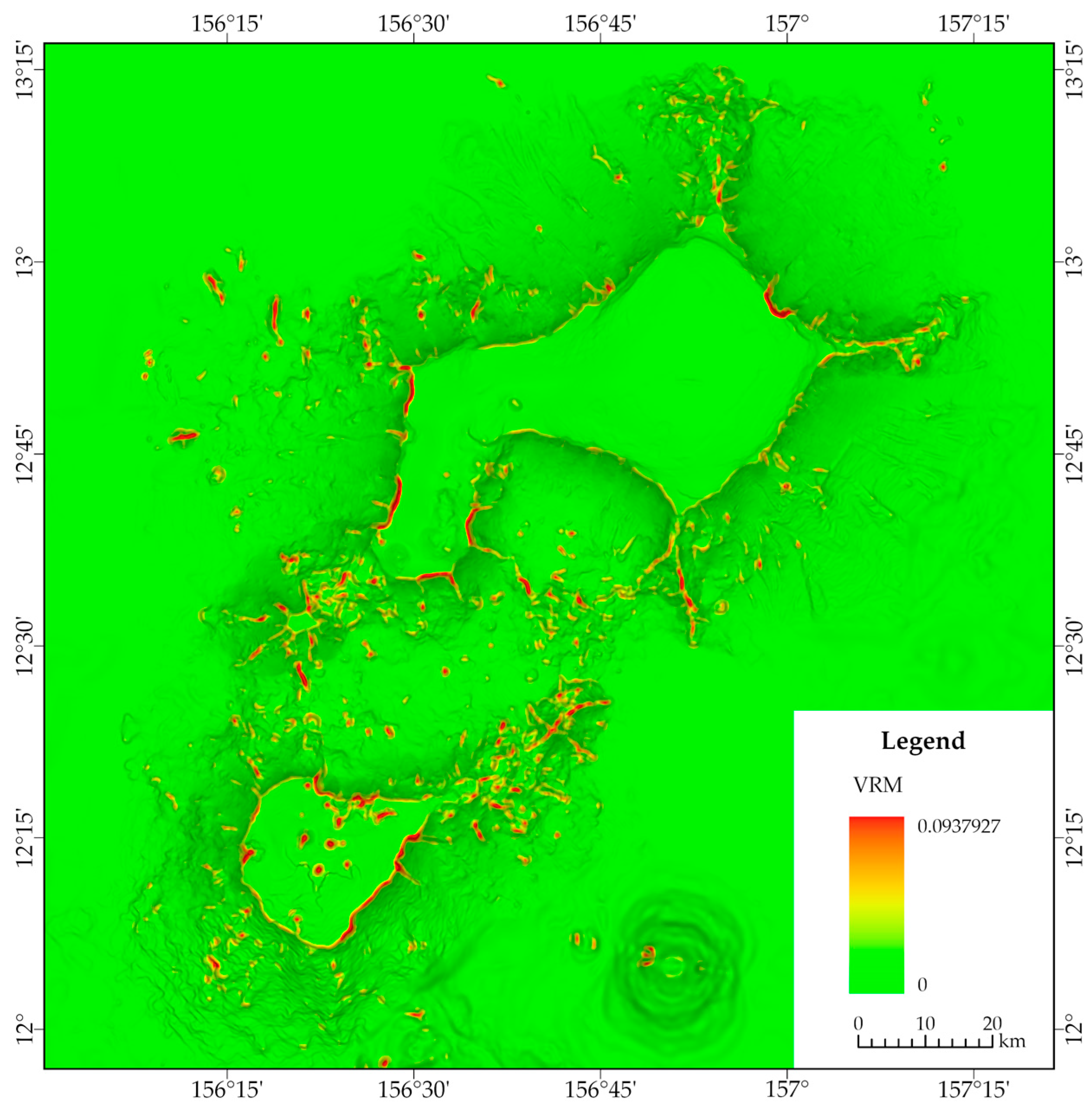

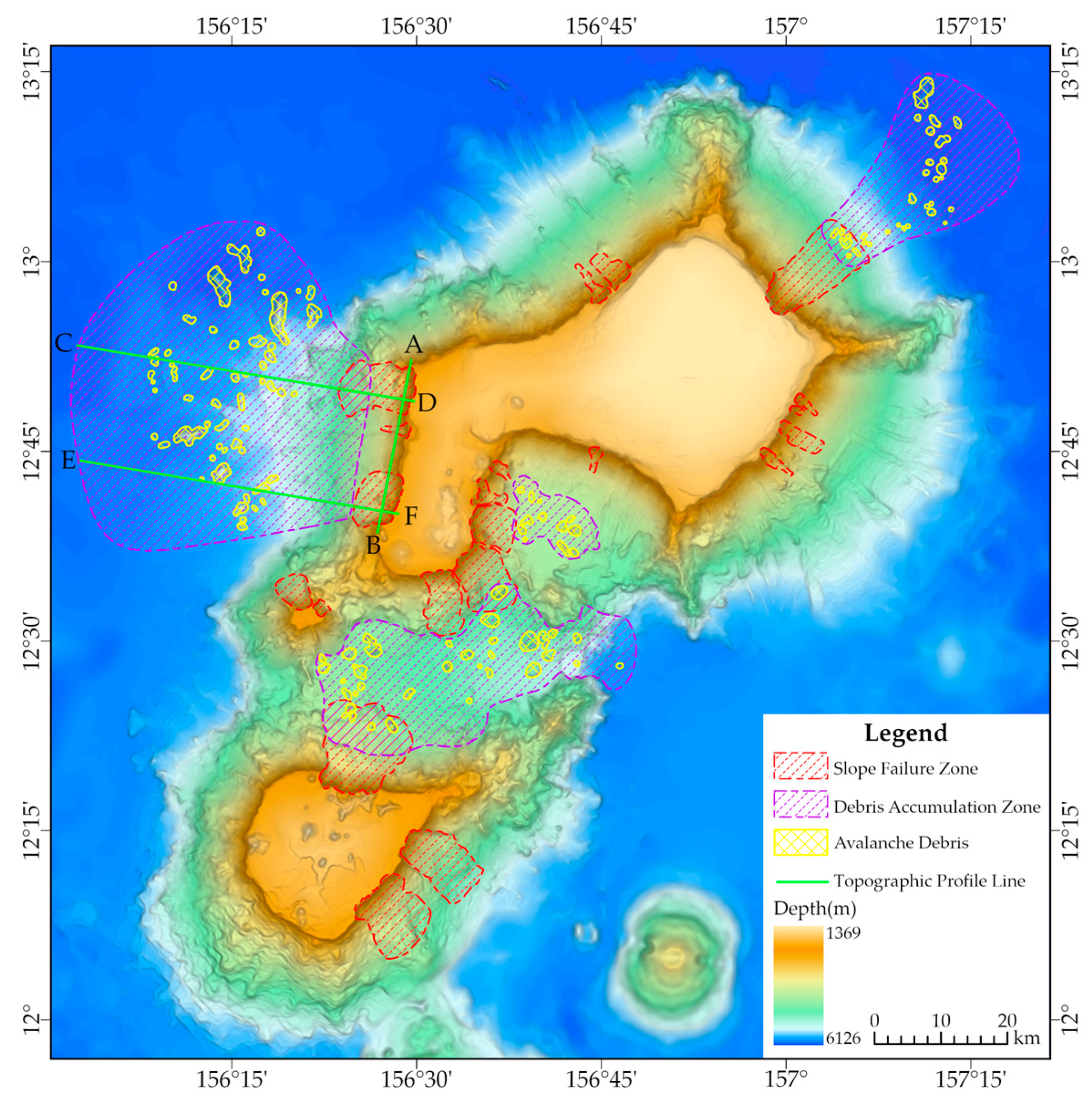
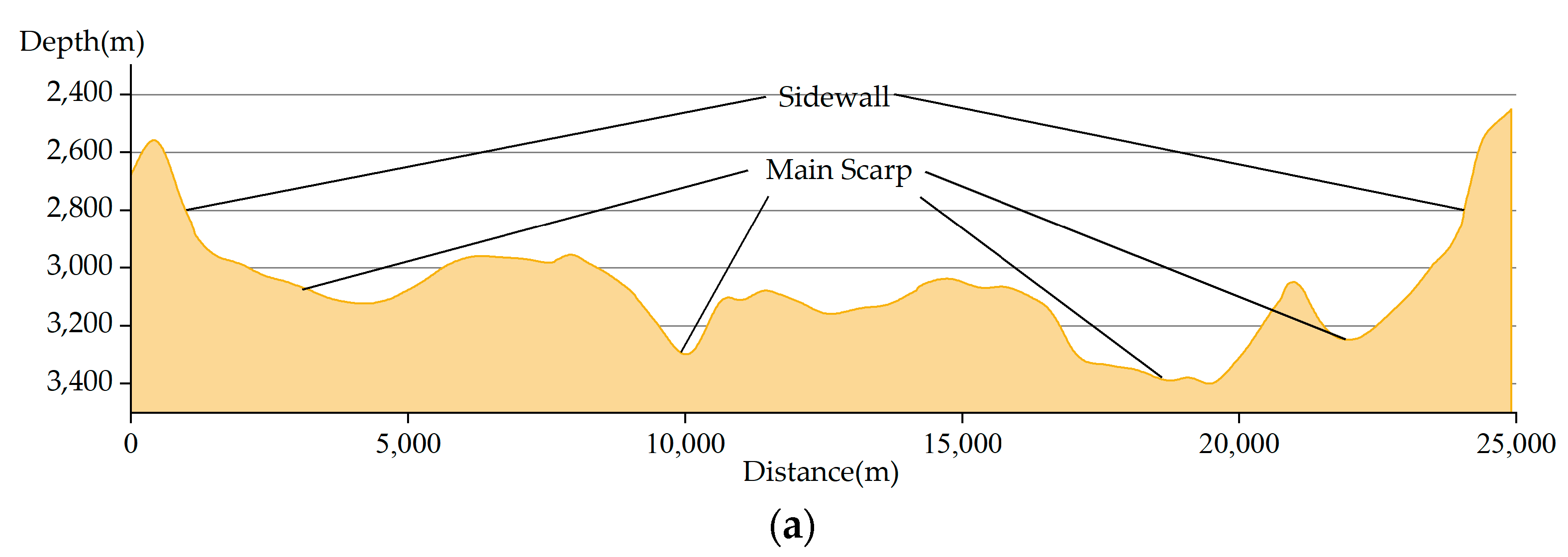
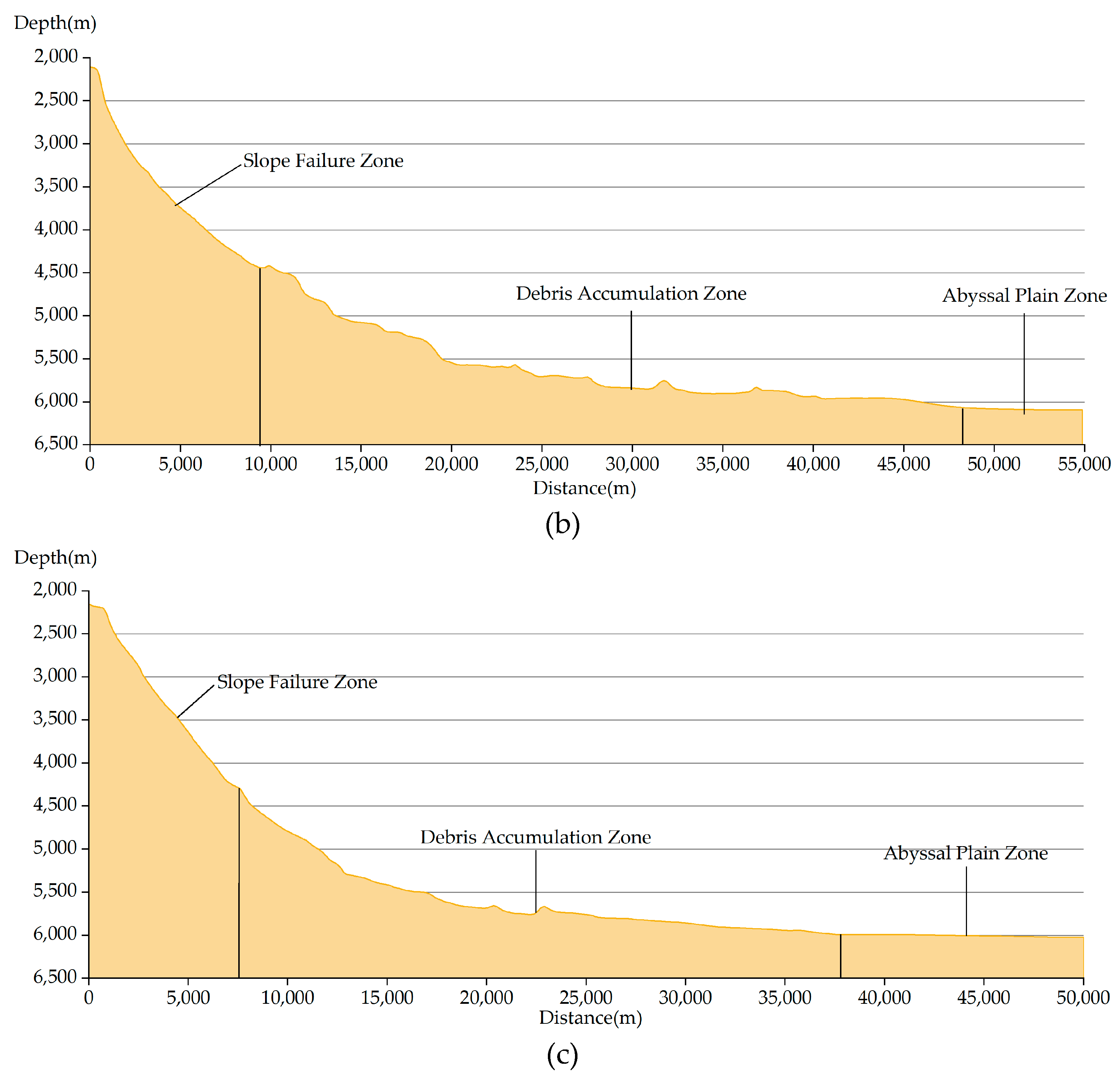
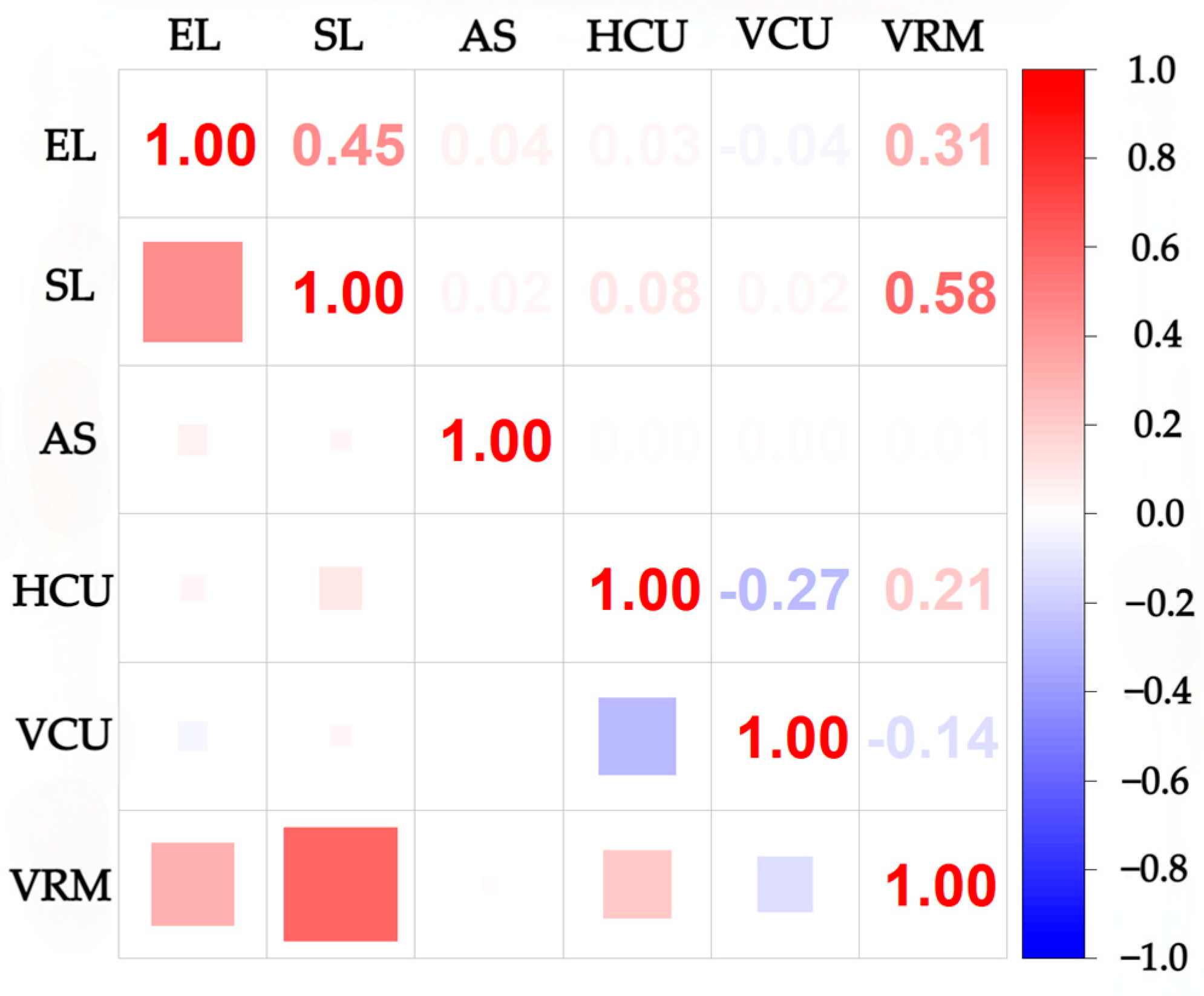
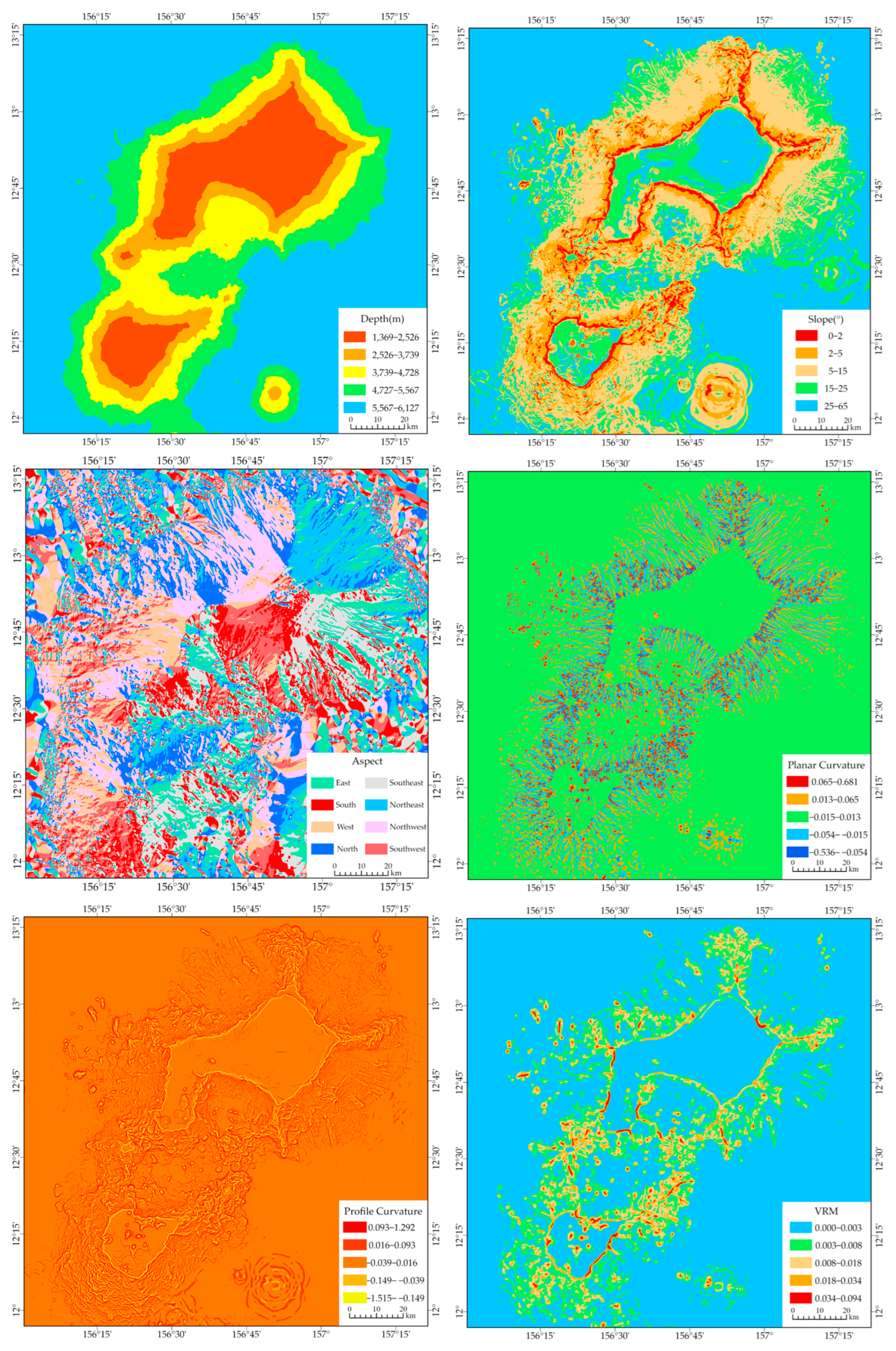
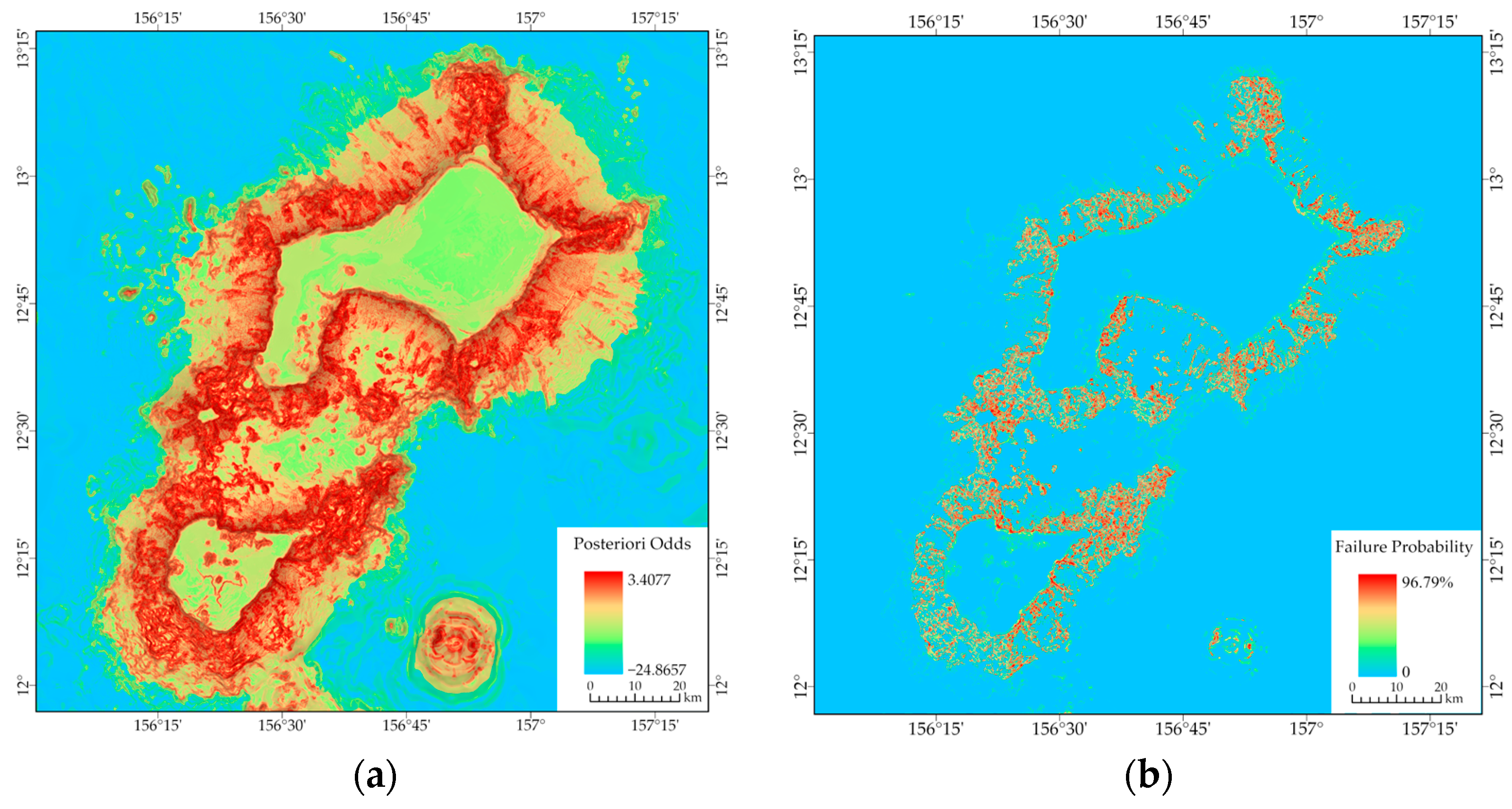
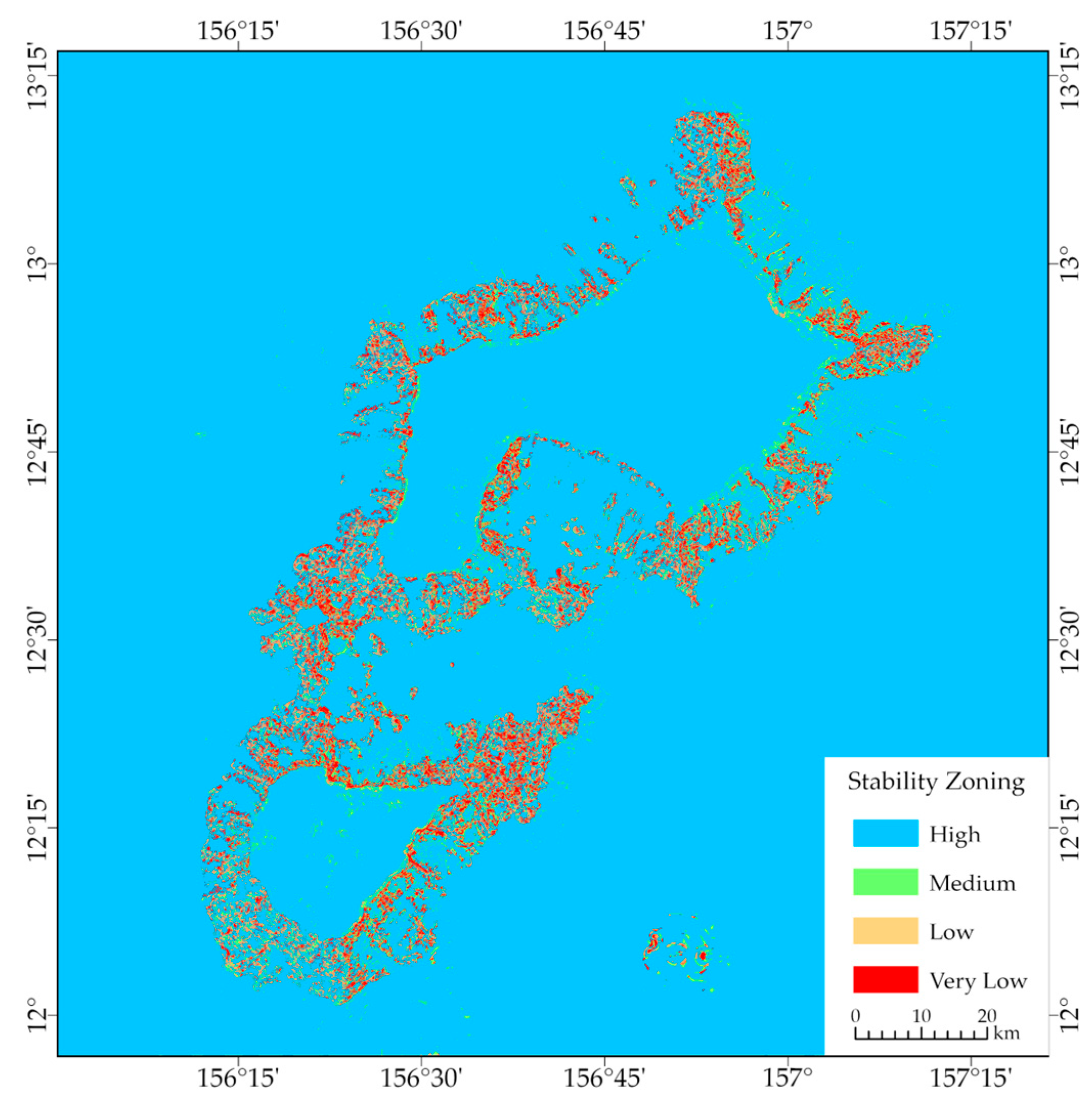
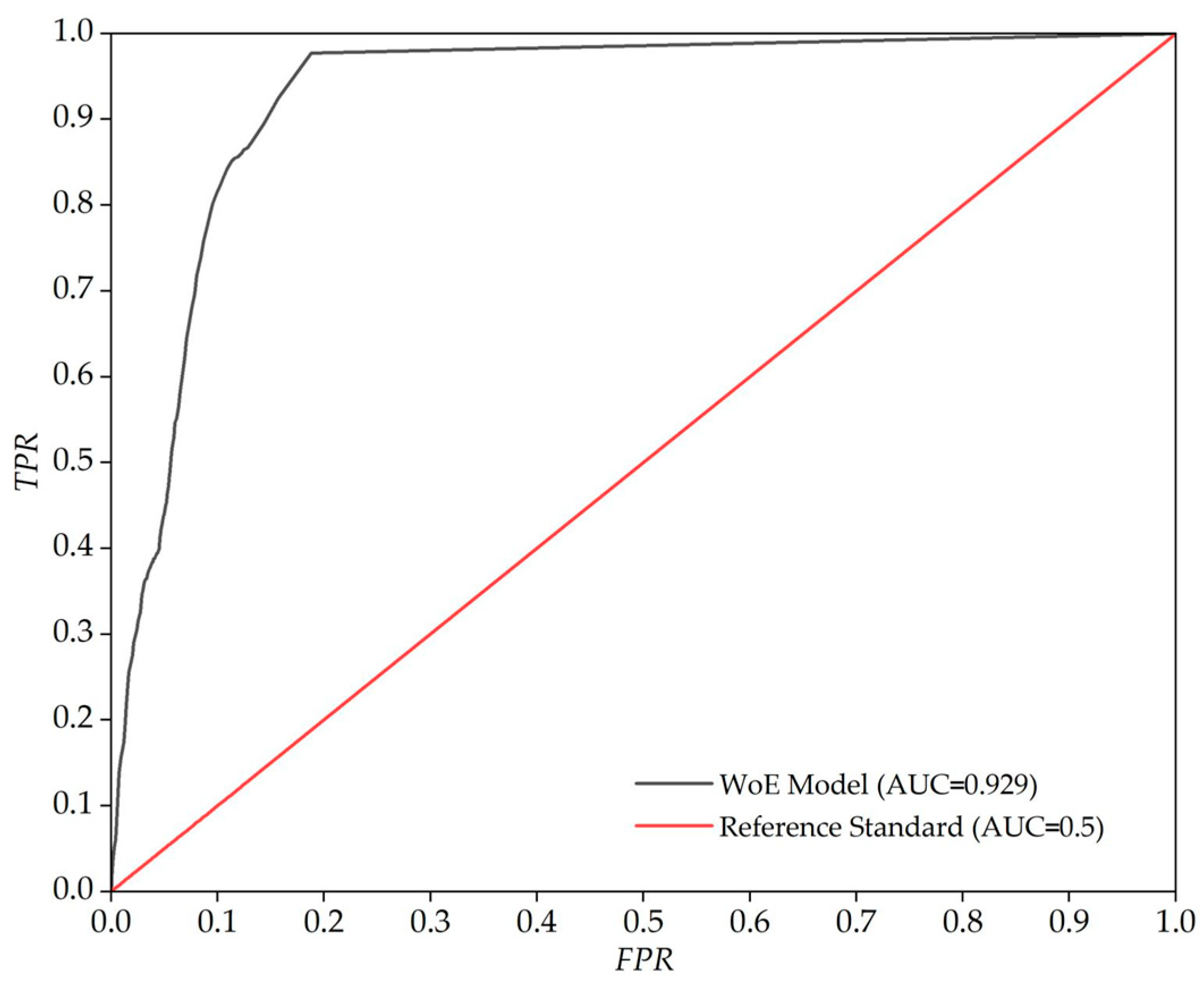
| The Evidence Factor of Slope | 0~2° | 2~5° | 5~15° | 15~25° | Above 25° |
|---|---|---|---|---|---|
| Total number of pixels in the assessment area | 8,750,609 | ||||
| Number of failure pixels in the assessment area | 249,854 | ||||
| Number of non-failure pixels in the assessment area | 8,500,755 | ||||
| A priori probability (O(F)) | 0.02939 | ||||
| Number of evidence factor pixels | 4,235,894 | 1,518,983 | 1,919,017 | 821,485 | 255,230 |
| Number of failure pixels in the evidence factor | 5209 | 19,941 | 120,661 | 68,876 | 35,167 |
| Number of non-failure pixels in the evidence factor | 4,230,685 | 1,499,042 | 1,798,356 | 752,609 | 220,063 |
| Number of failure pixels in the non-evidence factor | 244,645 | 229,913 | 129,193 | 180,978 | 214,687 |
| Number of non-failure pixels in the non-evidence factor | 4,270,070 | 7,001,713 | 6,702,399 | 7,748,146 | 8,280,692 |
| Positive weights () | −3.17270 | −0.79277 | 0.82539 | 1.13580 | 1.69323 |
| Negative weights () | 0.66746 | 0.11082 | −0.42188 | −0.22980 | −0.12547 |
| Relative coefficients (C) | −3.84016 | −0.90359 | 1.24727 | 1.36560 | 1.81870 |
| Comprehensive weight of evidence (W) | −3.83902 | −0.90246 | 1.24840 | 1.36673 | 1.81983 |
| Probability Grading | Stability Level | Proportion of Zone Area | Proportion of Failure Area |
|---|---|---|---|
| Below 25% | High | 93.04% | 1.93% |
| 25% to 50% | Medium | 2.47% | 10.50% |
| 50% to 75% | Low | 2.04% | 13.89% |
| Above 75% | Very Low | 2.45% | 15.45% |
| Probability | TP | P | FP | N | TPR | FPR |
|---|---|---|---|---|---|---|
| 96% | 0 | 10,887 | 106 | 8,739,722 | 0.00000 | 0.00001 |
| 90% | 560 | 10,887 | 26,488 | 8,739,722 | 0.05144 | 0.00303 |
| 80% | 2776 | 10,887 | 144,179 | 8,739,722 | 0.25498 | 0.01650 |
| 70% | 3813 | 10,887 | 260,892 | 8,739,722 | 0.35023 | 0.02985 |
| 60% | 4178 | 10,887 | 339,595 | 8,739,722 | 0.38376 | 0.03886 |
| 50% | 4328 | 10,887 | 388,274 | 8,739,722 | 0.39754 | 0.04443 |
| 40% | 4785 | 10,887 | 435,879 | 8,739,722 | 0.43952 | 0.04987 |
| 30% | 5945 | 10,887 | 524,392 | 8,739,722 | 0.54606 | 0.06000 |
| 20% | 7819 | 10,887 | 703,906 | 8,739,722 | 0.71820 | 0.08054 |
| 10% | 9256 | 10,887 | 985,202 | 8,739,722 | 0.85019 | 0.11273 |
| 0% | 10,887 | 10,887 | 8,739,722 | 8,739,722 | 1.00000 | 1.00000 |
Disclaimer/Publisher’s Note: The statements, opinions and data contained in all publications are solely those of the individual author(s) and contributor(s) and not of MDPI and/or the editor(s). MDPI and/or the editor(s) disclaim responsibility for any injury to people or property resulting from any ideas, methods, instructions or products referred to in the content. |
© 2025 by the authors. Licensee MDPI, Basel, Switzerland. This article is an open access article distributed under the terms and conditions of the Creative Commons Attribution (CC BY) license (https://creativecommons.org/licenses/by/4.0/).
Share and Cite
Yin, X.; Sun, Y.; Xu, W.; Gao, W.; Wang, H.; Ruan, S.; Shao, Y. Seafloor Stability Assessment of Jiaxie Seamount Group Using the “Weight-of-Evidence” (WoE) Method, Western Pacific Ocean. J. Mar. Sci. Eng. 2025, 13, 1001. https://doi.org/10.3390/jmse13051001
Yin X, Sun Y, Xu W, Gao W, Wang H, Ruan S, Shao Y. Seafloor Stability Assessment of Jiaxie Seamount Group Using the “Weight-of-Evidence” (WoE) Method, Western Pacific Ocean. Journal of Marine Science and Engineering. 2025; 13(5):1001. https://doi.org/10.3390/jmse13051001
Chicago/Turabian StyleYin, Xuebing, Yongfu Sun, Weikun Xu, Wei Gao, Heshun Wang, Sidi Ruan, and Yihui Shao. 2025. "Seafloor Stability Assessment of Jiaxie Seamount Group Using the “Weight-of-Evidence” (WoE) Method, Western Pacific Ocean" Journal of Marine Science and Engineering 13, no. 5: 1001. https://doi.org/10.3390/jmse13051001
APA StyleYin, X., Sun, Y., Xu, W., Gao, W., Wang, H., Ruan, S., & Shao, Y. (2025). Seafloor Stability Assessment of Jiaxie Seamount Group Using the “Weight-of-Evidence” (WoE) Method, Western Pacific Ocean. Journal of Marine Science and Engineering, 13(5), 1001. https://doi.org/10.3390/jmse13051001





